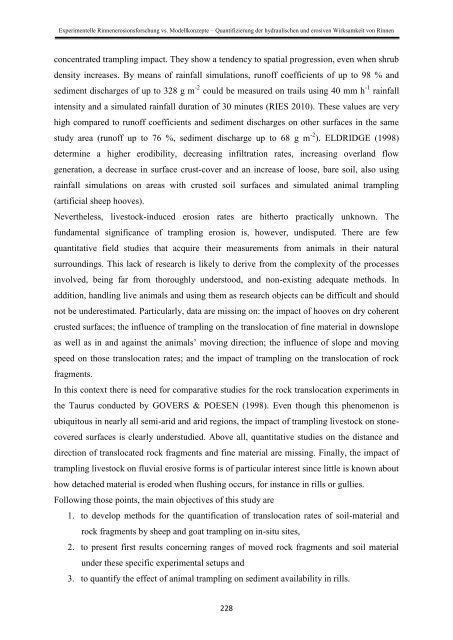Stefan Wirtz Vom Fachbereich VI (Geographie/Geowissenschaften ...
Stefan Wirtz Vom Fachbereich VI (Geographie/Geowissenschaften ...
Stefan Wirtz Vom Fachbereich VI (Geographie/Geowissenschaften ...
Create successful ePaper yourself
Turn your PDF publications into a flip-book with our unique Google optimized e-Paper software.
Experimentelle Rinnenerosionsforschung vs. Modellkonzepte – Quantifizierung der hydraulischen und erosiven Wirksamkeit von Rinnen<br />
concentrated trampling impact. They show a tendency to spatial progression, even when shrub<br />
density increases. By means of rainfall simulations, runoff coefficients of up to 98 % and<br />
sediment discharges of up to 328 g m -2 could be measured on trails using 40 mm h -1 rainfall<br />
intensity and a simulated rainfall duration of 30 minutes (RIES 2010). These values are very<br />
high compared to runoff coefficients and sediment discharges on other surfaces in the same<br />
study area (runoff up to 76 %, sediment discharge up to 68 g m -2 ). ELDRIDGE (1998)<br />
determine a higher erodibility, decreasing infiltration rates, increasing overland flow<br />
generation, a decrease in surface crust-cover and an increase of loose, bare soil, also using<br />
rainfall simulations on areas with crusted soil surfaces and simulated animal trampling<br />
(artificial sheep hooves).<br />
Nevertheless, livestock-induced erosion rates are hitherto practically unknown. The<br />
fundamental significance of trampling erosion is, however, undisputed. There are few<br />
quantitative field studies that acquire their measurements from animals in their natural<br />
surroundings. This lack of research is likely to derive from the complexity of the processes<br />
involved, being far from thoroughly understood, and non-existing adequate methods. In<br />
addition, handling live animals and using them as research objects can be difficult and should<br />
not be underestimated. Particularly, data are missing on: the impact of hooves on dry coherent<br />
crusted surfaces; the influence of trampling on the translocation of fine material in downslope<br />
as well as in and against the animals’ moving direction; the influence of slope and moving<br />
speed on those translocation rates; and the impact of trampling on the translocation of rock<br />
fragments.<br />
In this context there is need for comparative studies for the rock translocation experiments in<br />
the Taurus conducted by GOVERS & POESEN (1998). Even though this phenomenon is<br />
ubiquitous in nearly all semi-arid and arid regions, the impact of trampling livestock on stonecovered<br />
surfaces is clearly understudied. Above all, quantitative studies on the distance and<br />
direction of translocated rock fragments and fine material are missing. Finally, the impact of<br />
trampling livestock on fluvial erosive forms is of particular interest since little is known about<br />
how detached material is eroded when flushing occurs, for instance in rills or gullies.<br />
Following those points, the main objectives of this study are<br />
1. to develop methods for the quantification of translocation rates of soil-material and<br />
rock fragments by sheep and goat trampling on in-situ sites,<br />
2. to present first results concerning ranges of moved rock fragments and soil material<br />
under these specific experimental setups and<br />
3. to quantify the effect of animal trampling on sediment availability in rills.<br />
228
















